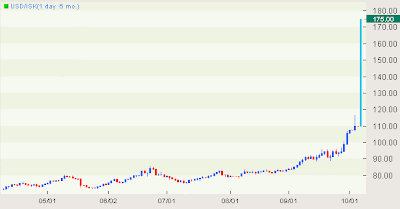

The Icelandic krona declined to the lowest level in almost seven years against the U.S. dollar yesterday after the rating downgrades by S&P and Fitch rating agencies raised the risk-averting mood among the investors.
The drop in this national currency reached more than 17 percent this week after the central bank pledged to nationalize the century-old Glitnir Bank as it failed to pay by its short-term debts. Investors believe that the central bank won’t be able to help all the banks and the country will face a strong financial crisis.
The USD/ISK is rising for the sixth day in a row now — the longest rally in more than 3 months. Traders lose confidence in the financial system, the Central Bank of Iceland and its ability to resist crisis. That plays against the krona’s value.
USD/ISK rose from 108.16 to 111.29 as of 13:12 GMT today. It reached 111.51 rate yesterday — the highest rate since November 2001 after closing at 94.35 at the last week’s trading session.
No comments:
Post a Comment